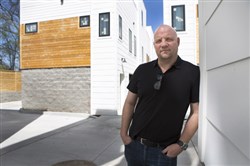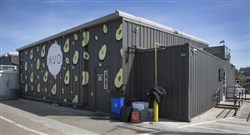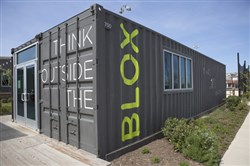VOL. 41 | NO. 14 | Friday, April 7, 2017
Shipping containers find new use as homes, businesses
By Linda Bryant

Shawn Bailes, President/CEO of FMBC Investments with his newest development along 2nd Ave. South.
-- Michelle Morrow | The LedgerDevelopers are often known more for their hustle than their patience. Time is usually money for them since they’re usually beholden to investors and lenders who expect a quick return on their money.
Nashville boutique developer Shawn Bailes says his most recent project, 83 Freight, has required plenty of commitment, patience and persistence. The $16 million 83-unit, 55,000-square-foot housing development will be constructed entirely with shipping containers and feature studio, one and two bedroom units.
83 Freight was announced in September 2016, but it took over a year for Bailes to jump all the hoops required to rezone the property from a base zoning that allowed 20 homes to one that will accommodate 83 units. And although he owns a section of the 2.3 acres site at 2150 Byrum Ave., Bailes held off on buying the final portion of it until he was absolutely sure the property was rezoned and could be used for his proposed project.
The building site is on the fringe of the popular Wedgewood-Houston artisan district and adjacent to land where the city is eyeing a potential soccer stadium.
The rezoning was recently approved by Metro Council on the third and final reading. Now, the remainder of the required land is under contract with Harvest Hands Community Development, a summer closing is expected, and a late groundbreaking is slated for later in 2017. When complete, 83 Freight will be one of a smattering of Nashville’s shipping container projects, and it will most certainly be the largest. Other shipping container residential and commercial projects in the area include a retail cluster at the oneC1TY mixed-use development that includes Avo restaurant, CrossFit Nashville and Nashville Sports League; The 404, a restaurant located in The Gulch; and Stack 19, a yet-to-be-constructed 13,000-square-foot short-term rental complex with 19 units and a small retail component.
“Capital is not very patient when it comes to developers,” Bailes says. “I was very patient with this project because I was using my own money, and it was my vision. When you have a slew of investors, they’re usually going to be focused on getting that return. They have to pick the low-lying fruit and ‘turn and burn’ their project. That’s why a lot of people hate developers. It seems like they are in and out very quickly.”
The spaces at 83 Freight will range in size from 320 to 1,280 square feet. Pricing has yet to be finalized because Bailes is still figuring out if the units will be a mix of for-rent and for-sale. But he is clear about one thing; the housing development is aimed at the “missing middle” segment of the housing market. He anticipates a base unit price of about $200,000.
Housing for the ‘missing middle’

AVO, a plant-based restaurant, made using packing containers. The restaurant is part of community of buildings along City Ave off Charlotte Pike that are made using packing containers.
-- Michelle Morrow | The LedgerThe “missing middle” is a relatively new housing term coined by nationally-known urban planner Daniel Parolek in 2010. It refers to smaller urban housing units – duplexes, townhomes, bungalow courts and apartments – that are integrated throughout traditional neighborhoods of single-family homes.
Missing middle housing developments are often seen as one of the solutions to solving the affordable and workforce housing crisis because they are smaller and make it possible for homebuyers or renters to pay less for them than a single-family home.
“Nashville is screaming for workforce housing,” Bailes says. “83 Freight is aimed at that missing middle demographic. (Examples of my target customer) could be hospitality workers, people working downtown who can’t afford to buy or rent in places like The Gulch or 12South and artists or creative types who might typically have gone in with one or two friends to rent an older house.
83 Freight gives them the flexibility of living in the inner core of the city, but not have to pay an arm and a leg for more than they actually need. They might even be people from a different city but who work here a lot and need an affordable place to live during the week.”
Bailes believes millennials in their twenties or thirties, who don’t necessarily own a car, like to walk and are reliant on riding sharing services such as Lyft or Uber or public transportation to get around will be drawn to 83 Freight.
He’s quick to point out that the project is 650 linear feet from a bus stop on Nolensville Pike and a short walk to the Wedgewood-Houston district, where there are restaurants, art galleries and $450,000 condos.
Bailes says many developers don’t want to tackle housing aimed at the missing middle because there’s often resistance from single-family homeowners and even council members, especially when they feel pressured by constituents.
The unpredictability of the upzoning process – and the time required to pursue it – scares many of his colleagues in the development community away, he says.
Instead, many developers have opted to build upscale housing with a much larger square footage because; getting zoning passed for such projects is often easier.
“There aren’t a lot of people who give credence to building small units,” Bailes says. “It irritates me. I really believe the solution to a lot of these (affordable urban housing) problems is to build smaller. And right, wrong or indifferent you have to increase density to get that affordability. Unless you are running a nonprofit it’s hard for a developer to make money because the land prices are so outrageous.”

OneCity, a mixed-used development off Charlotte Avenue near Centennial Park, is one of the first local sites to feature upcycled shipping containers.
-- Michelle Morrow | The LedgerFloyd Shechter, president of Nashville-based real estate company SmartSpace and a high-profile affordable housing advocate, says Bailes is onto something.
“You definitely do have a growing demand (for living and commercial space) from people who want to be closer to downtown, and who might only need or be able to afford a smaller space,” he says. “There is a large demand for homes less than $350,000 or rentals less than $1,400.”
Captivated by shipping containers
Bailes has imagined creating an innovative project with shipping containers for a decade and was initially inspired by small shipping container projects he saw in Europe.
“I was just waiting to find the right application for them,” he says.
Not only are shipping containers small and compact, using them as the primary building material makes it possible to use an innovative construction timeline. This aspect also captured Bailes’ imagination.
“With traditional development you have to put in all the infrastructure, utilities, storm water, grating, foundation (beforehand, and then you build the vertical (construction) on top of it,” he says. “This is a modular method, and you have the vertical built off site. You can erect it like Lincoln Logs on site.”
Just how popular is the shipping container trend and why does it seem to be taking hold?
Casey Tongg, a marketing strategist for CFR Rinkens, a shipping container company with offices located around the United States, says the trend is just getting started.
“It is difficult to gauge the demand for shipping containers as it relates to home building, simply because it’s a recent trend that is still gaining traction,” Tongg says. “In addition, many of these containers are purchased used from a variety of sources, rather than brand new. As these containers have grown in popularity, some large manufacturers have created separate divisions which create containers specifically designed for alternative uses, a sign that this trend will continue to build steam.”
The growing popularity is likely driven by value, Tongg adds.
“Creating homes out of shipping containers has become so popular because they are far more affordable than a traditional house,” she says. “They’re also focused on going green and recycling, another ongoing movement that is growing each year. The opportunity for creativity and innovation provides an endless palette of ideas for those interested in joining the tiny home campaign.
Tongg says builders typically purchase shipping containers from local ports, wholesalers, or even online and typically pay between $1,000 and $4,500 depending on size and condition.
“In terms of challenges, a used shipping container can present issues when it comes to the structural integrity of the unit,” she says. “It’s recommended that new shipping containers be utilized, but this presents an additional cost. Health and safety are another concern, as you can’t always be sure what was shipped in a used container in the past. Another challenge is the amount of usable space. These containers are limited by their dimensions. Once you account for the space needed to add things like drywall and flooring, the container shrinks even more.
“Lastly, valuable commodities like insulation and comfort could be at stake with a shipping container home. Since they are basically just big steel boxes, they will get very hot in the summer and very cold in the winter. Proper insulation is very important to counter this.”
83 Freight will be built with roughly 171 containers. There are five different floor plans, including one studio floor plan, two one-bedroom variations and two two-bedroom variations. The containers used for the project are called “one-shippers.”
“The one shippers are the one-way disposal units that arrive with non-toxic materials,” Bailes says.”The bill of lading (a document issued by a carrier to acknowledge receipt of cargo) will show what the contents of the container shipped are so we can assure that it is a clean unit. We use new or like new so there is not as many variations in the containers. Some are used and abused over time and make for tougher manipulation in the manufacturing process.”
Kailey Faber, director at Tenant Base Inc., a Nashville-based real estate technology firm that offers a free service to companies to help find and lease commercial real estate, says the demand for shipping container-inspired projects in on the upswing. She says many people are attracted to the “novelty of the shipping container idea.”
“I could definitely see the attraction and demand for more space like this if there were more inventory,” Faber says.
Developers aren’t the bad guys
Bailes is well aware that developers are often derided, especially by neighborhood groups when they feel compelled to protect their turf.
He thinks the characterization is unfair, but also approaches it with levity.
“It just seems like more and more people see developers as evil people,” he says. “It’s like when people see all politicians as evil. There are some bad ones, but that doesn’t mean they’re all bad.
“Sometimes, I joke and say I’m a spelling bee judge instead,” Bailes adds. “I’d love for people to start bringing in developers as part of the solution instead of finger pointing at us as a part of the problem.
“You have the masses with pitchforks and fire saying, “No these developers need to pay their fair share, they’re making too much money. We need a pound of flesh.”
But, according to Bailes, developers are often under tremendous pressures to make the numbers work on their projects.
“I have a lot of friends who used to rezone and just aren’t doing it anymore because it’s not worth it,” he says. “They’ll go to Chattanooga and Huntsville and use their capital there because it’s a lot easier route to develop their projects.”
What does Bailes think would immediately help developers who want to build smaller developments with higher densities?
His answer, to some who resist Nashville’s growth, may seem like a bitter pill.
“There’s so much talk about wanting more affordable housing,” he says. “There’s a solution for it but it requires more density. So often there’s a NIMBY attitude (not in my backyard) attitude, and people think density is going to create traffic nightmares.”
Bailes rejects that premise and says, when done right, density encourages public transportation.
“There should be a path to make it easier to increase density, (especially when it comes to building smaller, more affordable units), he says.
What would make an immediate difference?
“I’ve never seen this done, but I’d like to see us have certified developers for the city,” he says. “If you’re a certified developer you should be able to be fast-tracked. I’d be the first one to donate money and help start the program.”
“If you’re going to push innovation there has to be a welcoming party that will openly embrace innovation.”